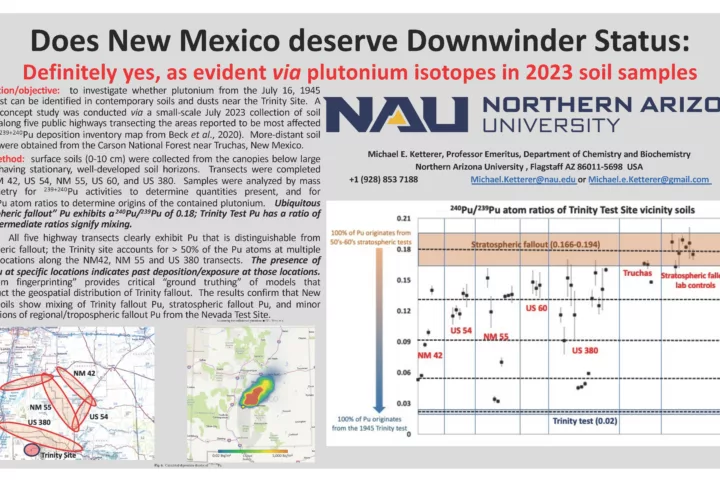For immediate release July 28, 2016
LANL Estimate of $2.9 Billion for “Remaining” Cleanup
Leaves Nuclear & Toxic Wastes Behind and Kills Needed Jobs
Santa Fe, NM – The Department of Energy (DOE) has announced that the cost of “Remaining Legacy Cleanup” of radioactive and toxic wastes from more than 70 years of nuclear weapons research and production at the Los Alamos National Laboratory (LANL) will cost $2.9 billion through fiscal year 2035, averaging $153 million per year.
That cost estimate clearly assumes that the Lab’s major radioactive and toxic wastes dumps will not be cleaned up. Instead they will be “capped and covered,” leaving some 200,000 cubic yards of radioactive and toxic wastes at Area G, its largest waste dump. Those wastes sit in unlined pits and trenches, 800 feet above groundwater and three miles uphill from the Rio Grande (plutonium contaminants have been detected 200 feet below Area G). During this same period of time the Lab’s nuclear weapons programs that caused the mess to begin with will cost ten times as much, even before expected funding increases for expanded production of plutonium bomb core “pits” and increasingly aggressive “Life Extension Programs” that give existing nuclear weapons new military capabilities.
DOE’s announcement also pegs the cost of past cleanup at LANL at $3.2 billion to date, raising the question of what has been and will be accomplished with precious taxpayer dollars. The answer is not much for the money. According to DOE’s own data, for the next couple of years only around a sixth of LANL’s “cleanup” funding will actually go to cleanup. Approximately one-third will be used to catch up on worker pensions and another third to babysit improperly treated radioactive waste barrels, one of which ruptured and closed the multi-billion dollar Waste Isolation Pilot Plant. More than half of the remaining one-third for real cleanup goes to LANL’s notoriously high overhead.
DOE’s cost estimate for future LANL cleanup assumes flat funding out to FY 2035, and notes how that cost is “Aligned to [the] 2016 Consent Order.” Despite repeated requests, DOE refused to estimate cleanup costs at LANL until a new Consent Order was finalized with the New Mexico Environment Department (NMED). Both agencies recently signed it, creating a giant loophole in which the Lab can claim that cleanup is too expensive or impractical to achieve. This is the exact opposite of the original 2005 Consent Order, whose underlying intent was to make DOE and LANL ask Congress for additional cleanup funding. Subsequently, funding for LANL cleanup has fallen from $224 million in FY 2014 to $189 million requested for FY 2017.
Under the Gov. Martinez Administration, NMED Secretary Ryan Flynn granted more than 150 milestone extensions to the 2005 Consent Order at the Lab’s request and then claimed that the old Consent Order did not work. Nuclear Watch New Mexico has filed suit against DOE and LANL for missing compliance milestones under the original Consent Order, with potential fines of more than $300 million. NMED explicitly absolves those violations and fines through the new Consent Order and has intervened in the lawsuit against NukeWatch. This raises the question of whose side the Environment Department is on, the environment or the polluter (in this case, a $2.3 billion per year nuclear weapons facility)?
DOE and NMED kill the chance for serious job creation at the Los Alamos Lab with a deceptive plan for so-called cleanup that leaves tons of radioactive and toxic wastes in the ground that will permanently threaten northern New Mexico’s precious water resources. In addition to the environmental and safety threats and contamination, nuclear weapons programs are not big producers of new jobs. For example, the environmental impact statement for a planned $6.5 billion plutonium facility for expanded nuclear weapons production explicitly stated that not one new Lab job would be created because it would merely relocate existing jobs. In contrast, a LANL study of full cleanup of Area G assumed that around 40% of the total cost would go to labor. Thus, as a rough approximation, for every additional billion dollars put into cleanup, another 3,000 years of cleanup work could be created for one hypothetical worker (in other words, hundreds of high paying jobs for the regional economy).
Jay Coghlan, NukeWatch Director, commented, “The Department of Energy and the New Mexico Environment Department deal New Mexicans a bad hand by pushing a plan that blocks genuine cleanup at the Los Alamos Lab. We need real cleanup that protects our precious water resources for future generations, not more nuclear bombs that cause the mess to begin with.”
# # #
DOE’s presentation on its cost estimate for future LANL cleanup is available at

